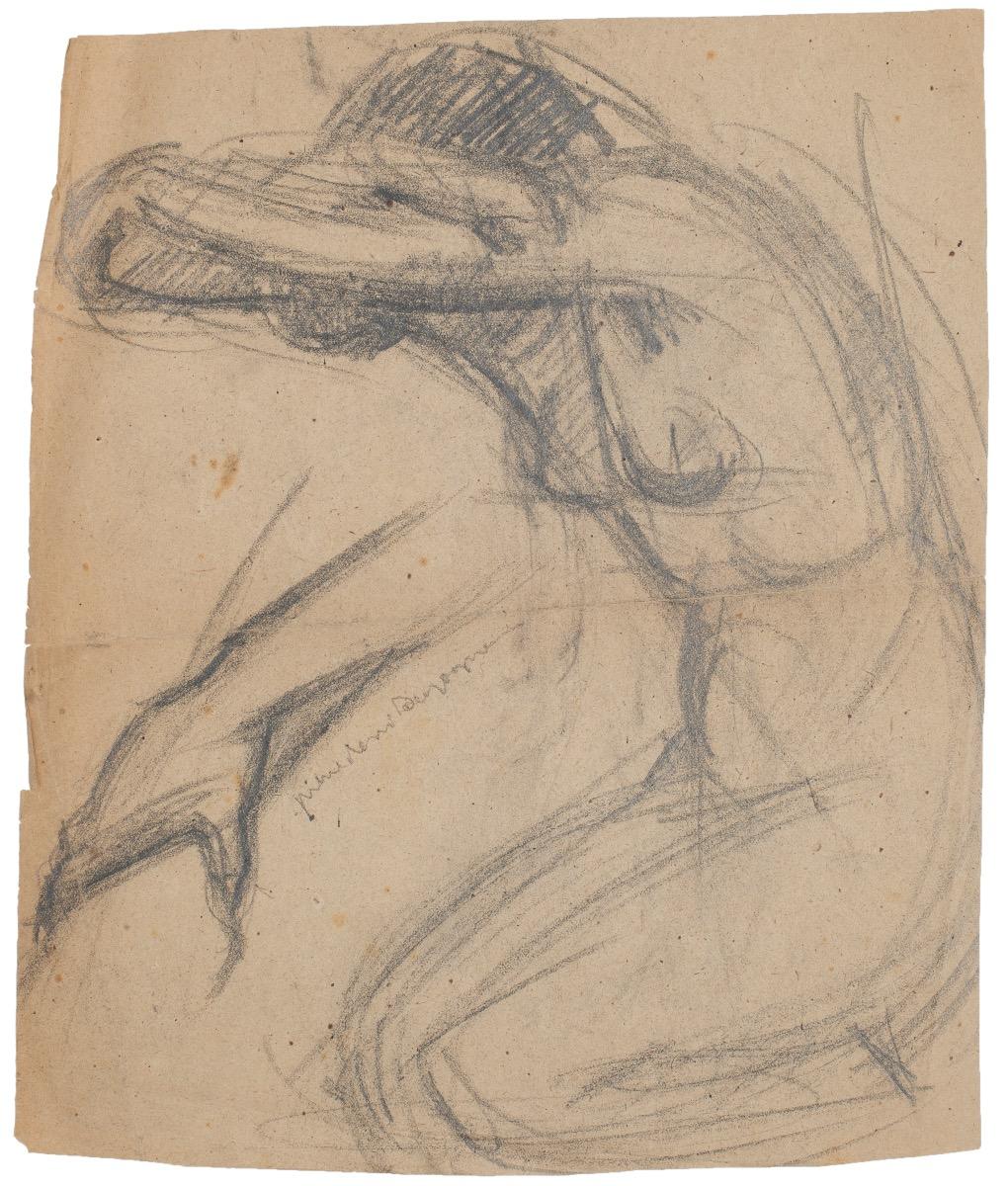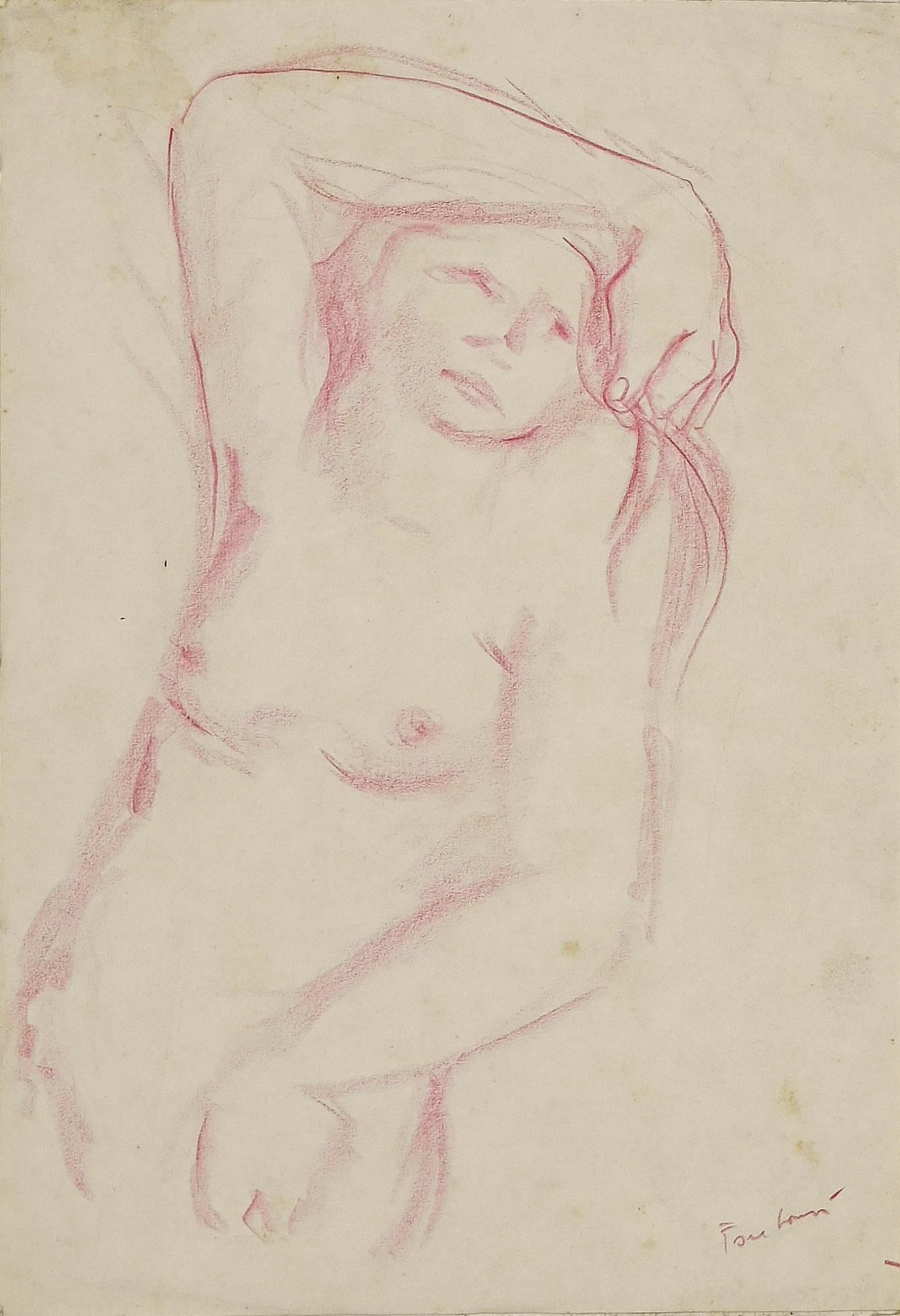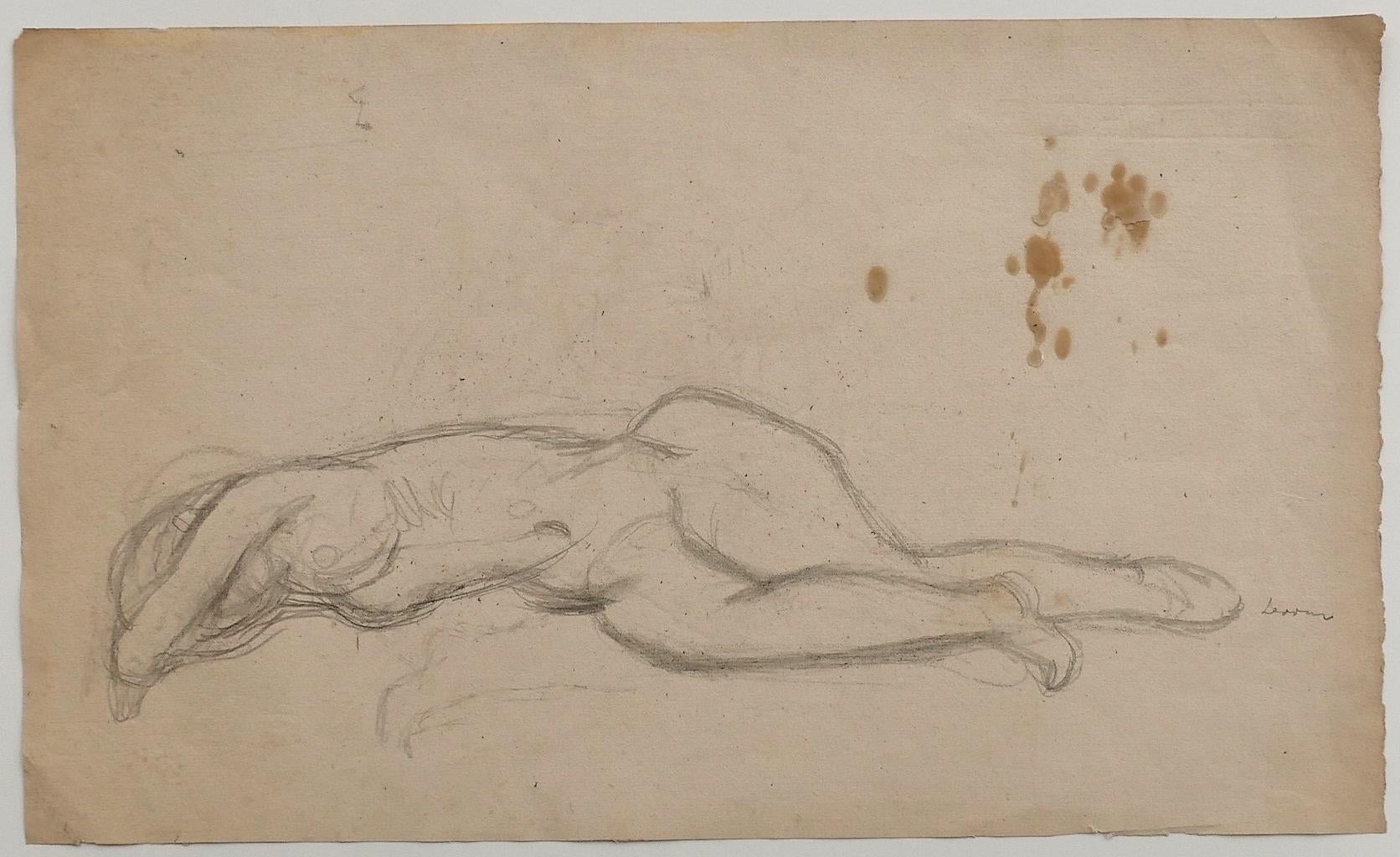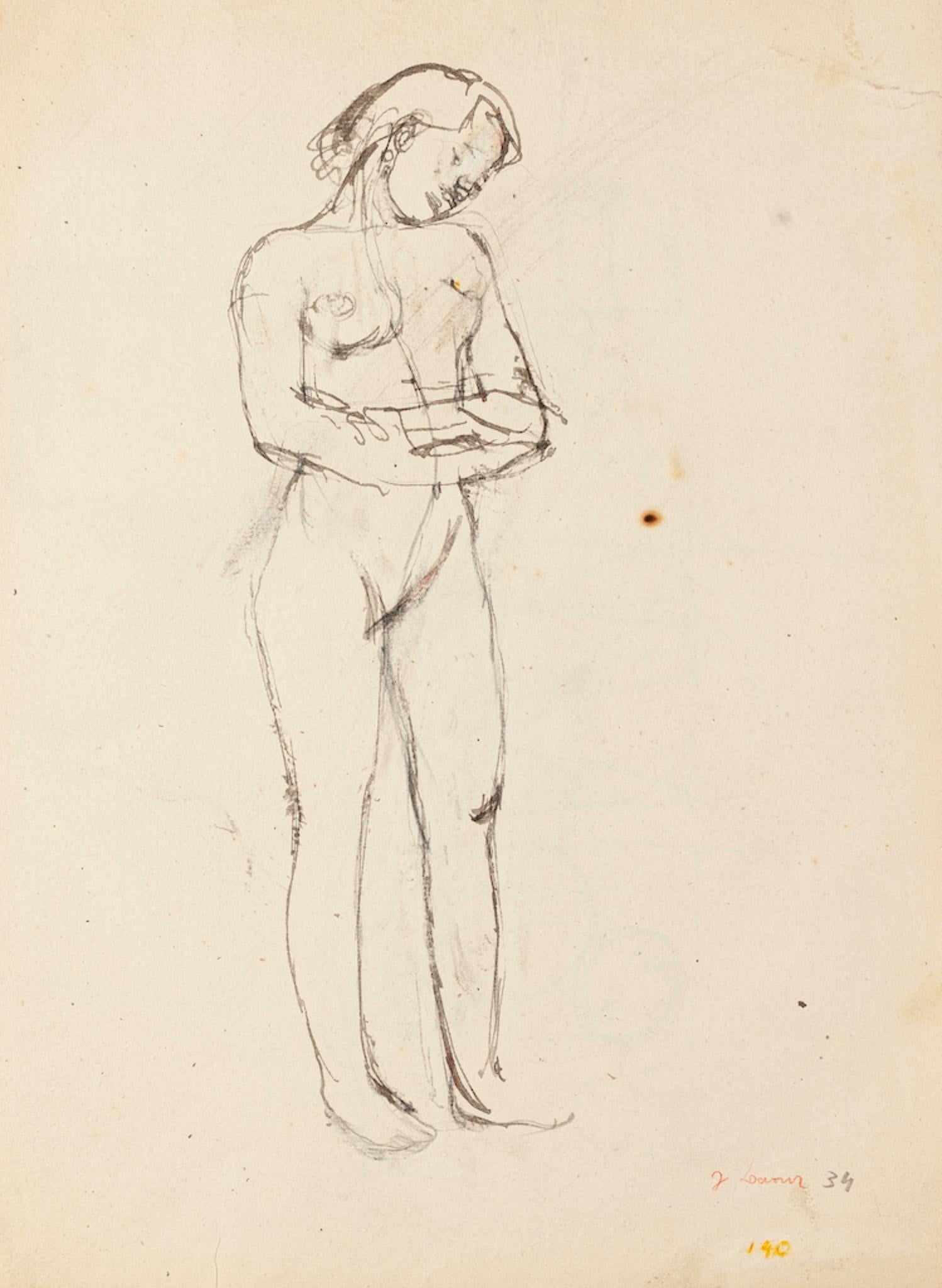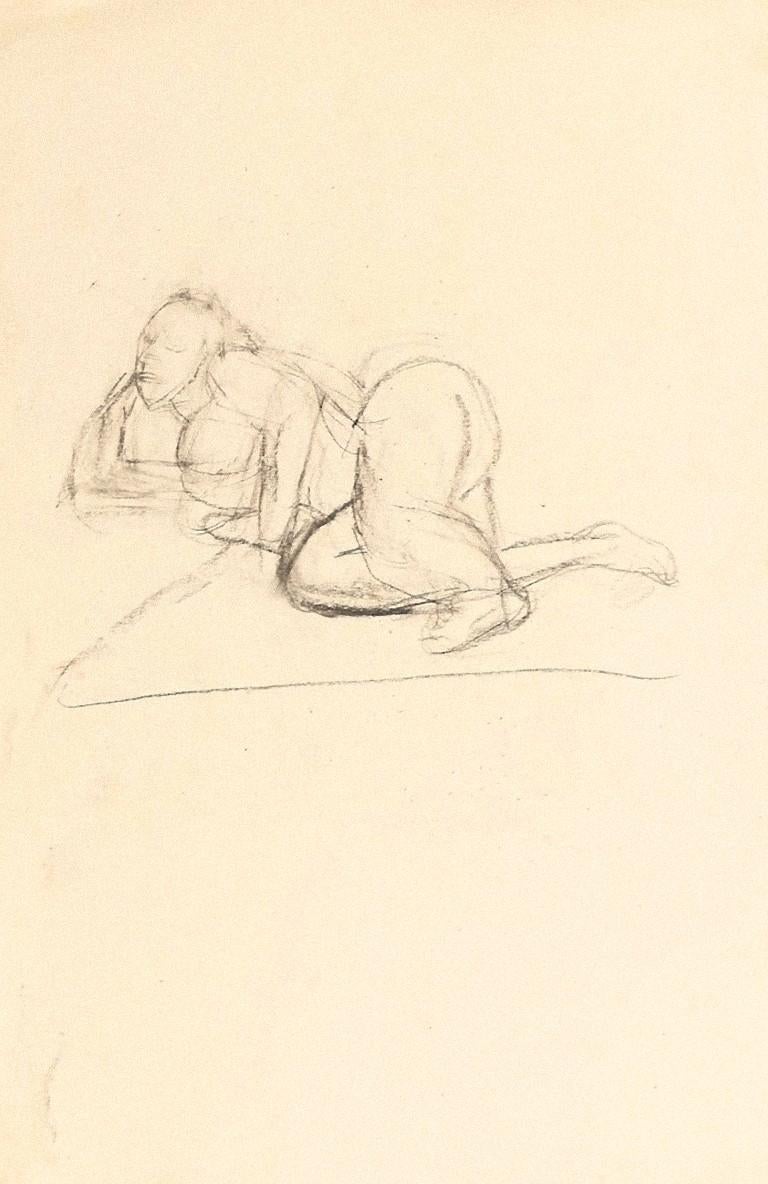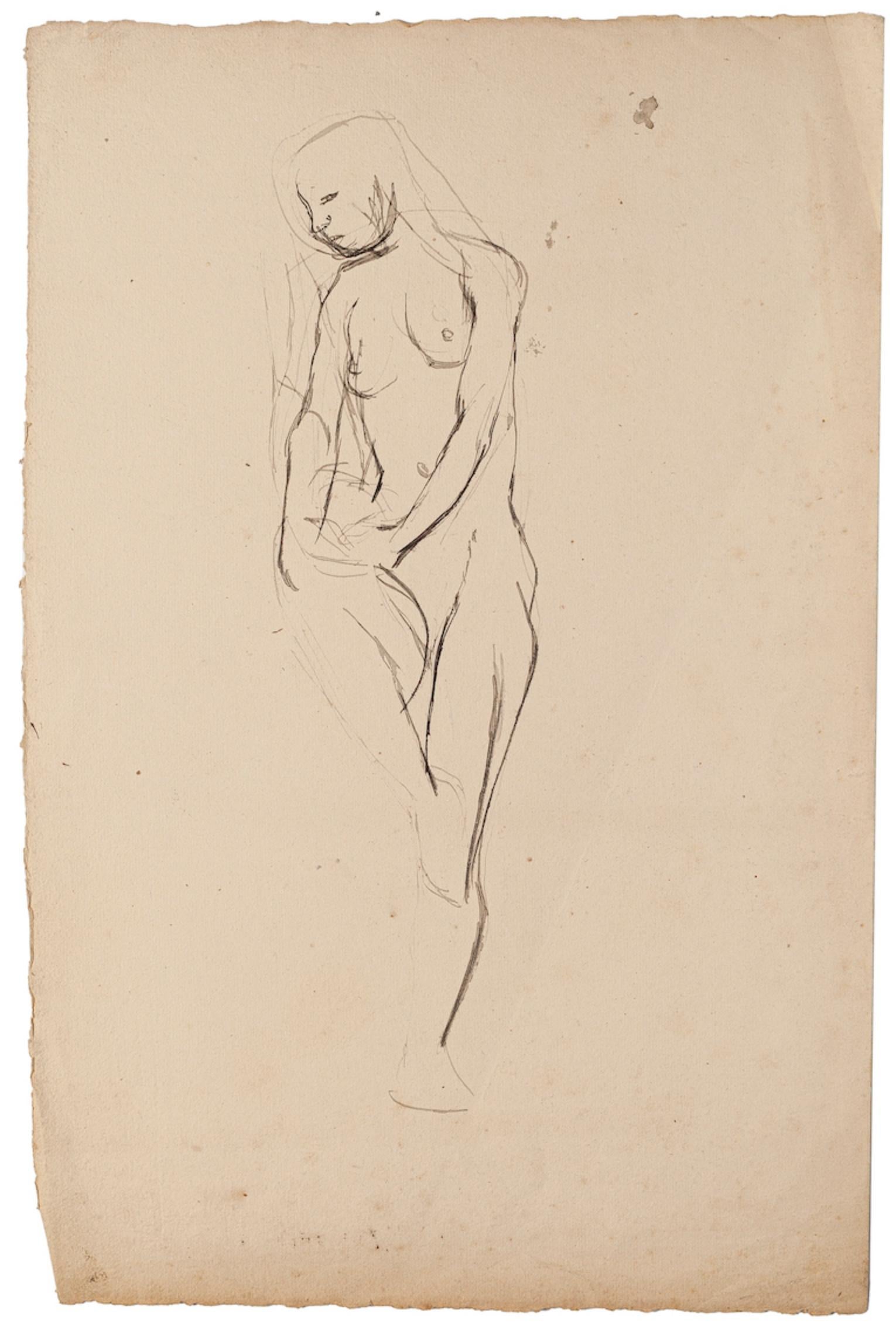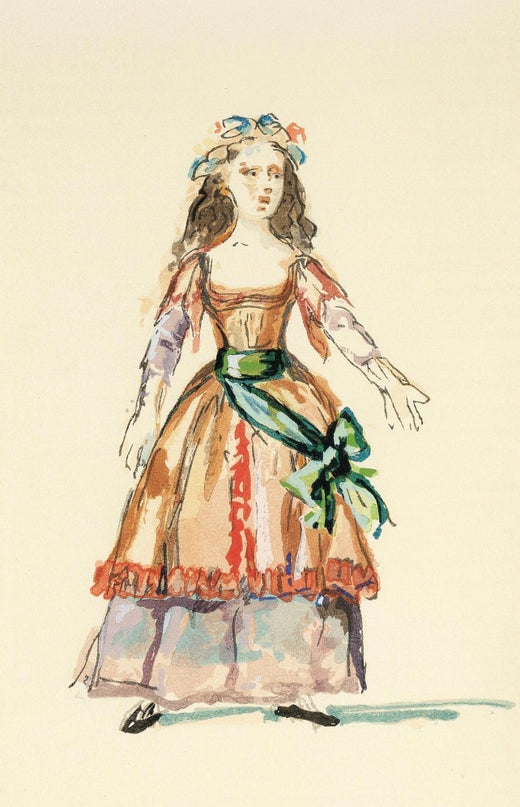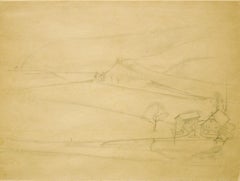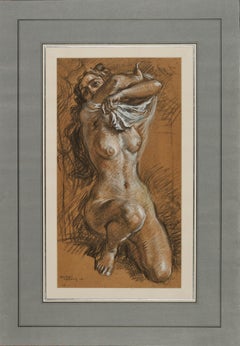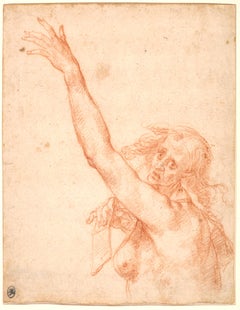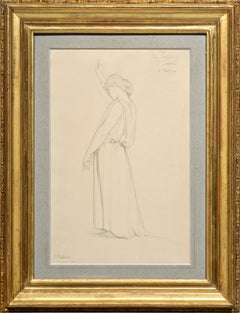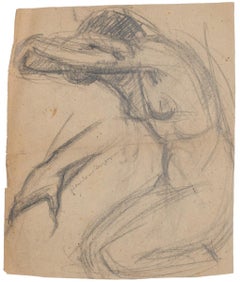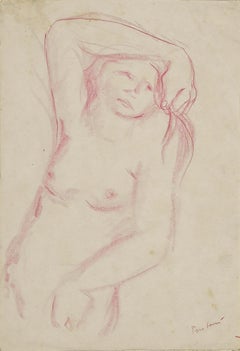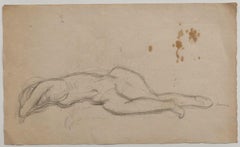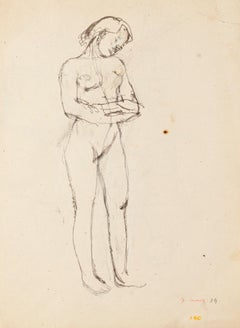Items Similar to Study for "Getting up" – 1955, a preparatory drawing by Balthus (1908 -2001)
Want more images or videos?
Request additional images or videos from the seller
1 of 8
Balthus (Balthasar Klossowski de Rola) Study for "Getting up" – 1955, a preparatory drawing by Balthus (1908 -2001)1955
1955
$27,314.48
£20,220.56
€23,000
CA$37,632.78
A$41,928.22
CHF 21,888.52
MX$509,064.51
NOK 275,124.37
SEK 260,059.37
DKK 175,126.07
About the Item
In 1955, as he was residing at the Château de Chassy in the Morvan for two years, Balthus created a large painting entitled "Getting up". Balthus was inspired for this painting by the Italian masters and used his companion Frédérique Tison as a model. This masterful nude study, preparatory to the painting, was formely in the model’s collection. It reveals both her femininity and her fragility, and takes us to the heart of Balthus' ambiguous artistic universe.
Provenance: Frédérique Tison, Château de Chassy (Burgundy-Franche Comté - France)
Exhibition: Bevaix, Galerie Arts Anciens Balthus, paintings, watercolours, drawings November - December 1975 - number 21 of the catalogue (reproduced in black and white)
Bibliography: J. Clair, V. Monnier Balthus, catalogue raisonné de l’oeuvre complète, Gallimard, Paris 1999 - number D843 reproduced in black and white (page 285)
Related works: A very similar study for “Getting Up” (55.2 x 43 cm) sold on May 8th 2014 at Sotheby's New York (lot 388) for $50,000 (the equivalent of €36,000). It is listed as D844 in the catalogue raisonné, which suggests that it was done just after ours. A larger (103 x 68.5 cm) and more accomplished study sold for 650,000 FRF (hammer price - equivalent to 99,000 €) at Briest in Drouot Montaigne on June 17th 1997 (lot 19).
1. The stay at Chassy, a key stage in Balthus' life
Balthus occupies a special place in 20th century art, which is often marked by the legacy of Marcel Duchamp or turned towards abstraction. Balthus on the contrary presents a figurative work, based on rigorous drawing and characterized by his ability to master form through meticulous construction. The work attracts and the artist disconcerts; there is somewhat of a "Balthus mystery", largely maintained and staged by the artist himself. During his lifetime, his work was the subject of numerous exhibitions organised in the world's greatest museums (at the Musée des Arts Décoratifs in Paris in 1966, at the Tate Gallery in London in 1968, at the Centre Pompidou in Paris and at the Metropolitan Museum of Art in New York in 1983-1984, and at the Palazzo Grassi in Venice in 2001, to name but a few).
Balthus was born on 29 February 1908 into a cosmopolitan family; his father was of Prussian and Polish origin and his mother, Elsa Dorothea Spiro, nicknamed Baladine, was of Ashkenazi and Russian descent. At the beginning of the war, his family took refuge in Switzerland, where he stayed with his mother while his parents separated. In 1919, his mother met the poet Rainer Maria Rilke (1875 - 1926) who became her lover; Balthus (the nickname of the painter from which he chose his artist's name) was brought up in the artistic milieu of his mother's friends.
Balthus moved to Paris with his mother in 1924. He enrolled at the Grande Chaumière academy and frequented Pierre Bonnard's studio. In 1926, he travelled to Italy where he discovered the frescoes of Piero della Francesca and Masaccio, which had a lasting influence on his art. Influenced by the surrealists, he held his first solo exhibition in 1934. Alongside his paintings, which were increasingly successful, he created several theatre, ballet and opera sets, an activity he continued after the war. In 1938, he held his first exhibition in New York.
He married Antoinette de Watteville (1912-1997) in 1937, and, during the war, the couple moved to Switzerland. Their two sons were born there. In 1945 the couple separated and Balthus returned to Paris.
In 1953, Balthus, then aged 45, decided to move to the Château de Chassy in the Morvan region. He was soon joined there by his niece by marriage (the daughter of his brother Pierre Klossowski's wife from her first marriage), Frédérique Tison, who became his muse and mistress. At Chassy, facing the landscapes of the Morvan, in the immense space of the house, Balthus worked and created a huge number of works. His painting evolved to become closer to the fresco, in the manner of the Italian Renaissance masters.
Frédérique Tison accompanied Balthus to Rome when he was appointed Director of the Villa Medici by André Malraux in 1961. When they finally broke up in 1966, Balthus gave her Chassy where she settled. In 1962, during a trip to Japan, Balthus met Setsuko Ideta. She became his wife in 1967. In 1977, at the end of their time in Rome, they settled in a large chalet in Rossinière (Switzerland) where the painter lived until his death on 18 February 2001.
2. Getting up : description of the artwork and sources of inspiration
Balthus produced few artworks and they were sought after very early on in his career. Most of his drawings were executed in the preparatory phase of large paintings. For example, this drawing is a study for Getting up (161 x 130.4 cm), painted in 1955, which is displayed at the Scottish National Gallery of Modern Art in Edinburgh (UK). Here Balthus depicts his favourite subject: the naked body of an adolescent girl offering herself to his pencils.
The drawing is reminiscent of Rodin's watercolours, but differs from them in the precision of the line, which gives it great clarity. As the art historian Serge Lemoine wrote, "the line sums up, condenses, synthesizes the form [...] When more volume is needed, to accentuate its value, to indicate a mass, Balthus resorts to hatching. The watercolour highlights, applied sparingly and without disorder, accentuate the impression of clarity and light.”
Frédérique Tison was 17 years old when she was used as a model for Getting up. She arrived a year earlier at Chassy and gradually became the artist's muse and companion. She is represented here from the front, in an ambiguous position that reveals both her determination and a certain fragility.
Her position is derived from a painting by Michelangelo Merisi, known as Caravaggio (1571-1610) Amor Omnia Vincit, also known as Amor Victorious, a painting that is now at the Gemäldegalerie in Berlin (Germany). This picture was painted around 1601-1602, with dimensions close to those of Balthus' painting (156 x 116 cm). Should we see in its subject a key to understanding the real meaning of our painting, and read in Getting up a confession of Balthus' love for his model?
The pose of Amor Victorious places him in an unstable balance in which he reveals his entire anatomy without concession. Depicted from the front and with no possible escape, the body of Getting up is both triumphant and vulnerable. The pose emphasizes the girl's femininity, suggesting another possible reading: an allegorical vision of her awakening sexuality.
The fact that the head is raised backwards, unlike Caravaggio's painting, forbids any relationship between the model and the viewer, and creates a mood of strangeness. This detail is even more visible in the drawing, in which the head is like a barely sketched theatrical mask, with no connection to the body and which appears to have been placed on this powerful and majestic body.
We have chosen to frame this drawing in a 17th century Spanish frame, probably unfinished as it was left in natural wood.
- Creator:Balthus (Balthasar Klossowski de Rola) (1908 - 2001, French)
- Creation Year:1955
- Dimensions:Height: 21.54 in (54.7 cm)Width: 16.62 in (42.2 cm)
- Medium:
- Movement & Style:
- Period:
- Condition:Signed with a “Bs.” monogram lower right 54.7 x 42.2 cm (framed 88.5 x 76 cm) Provenance: Frédérique Tison, Château de Chassy (Burgundy-Franche Comté - France) A very similar study sold on May 8th 2014 at Sotheby's New York (lot 388) for $50,000.
- Gallery Location:PARIS, FR
- Reference Number:1stDibs: LU156828902532
Balthus (Balthasar Klossowski de Rola)
Balthus was born on 29 February 1908 into a cosmopolitan family; his father was of Prussian and Polish origin and his mother, Elsa Dorothea Spiro, nicknamed Baladine, was of Ashkenazi and Russian descent. At the beginning of the war, his family took refuge in Switzerland, where he stayed with his mother while his parents separated. In 1919, his mother met the poet Rainer Maria Rilke (1875 - 1926) who became her lover; Balthus (the nickname of the painter from which he chose his artist's name) was brought up in the artistic milieu of his mother's friends. Balthus moved to Paris with his mother in 1924. He enrolled at the Grande Chaumière academy and frequented Pierre Bonnard's studio. In 1926, he travelled to Italy where he discovered the frescoes of Piero della Francesca and Masaccio, which had a lasting influence on his art. Influenced by the surrealists, he held his first solo exhibition in 1934. Alongside his paintings, which were increasingly successful, he created several theatre, ballet and opera sets, an activity he continued after the war. In 1938, he held his first exhibition in New York.
He married Antoinette de Watteville (1912-1997) in 1937 and the couple settled during the war first in Champrovent in Savoie, then in Fribourg in Switzerland where two of their sons were born and finally in Cologny near Geneva from 1942 onwards. In 1945 the couple separated and Balthus returned to Paris. In 1953, Balthus, then aged 45, decided to move to the Château de Chassy in the Morvan region. He was soon joined there by his niece by marriage (the daughter of his brother Pierre Klossowski's wife from her first marriage), Frédérique Tison, who became his muse and mistress. At Chassy, facing the landscapes of the Morvan, in the immense space of the house, Balthus worked and created a huge number of works. His painting evolved to become closer to the fresco, in the manner of the Italian Renaissance masters. Frédérique Tison accompanied Balthus to Rome when he was appointed Director of the Villa Medici by André Malraux in 1961. When they finally broke up in 1966, Balthus gave her Chassy where she settled. In 1962, during a trip to Japan, Balthus met Setsuko Ideta. She became his wife in 1967. In 1977, at the end of their time in Rome, they settled in a large chalet in Rossinière (Switzerland) where the painter lived until his death on 18 February 2001.
About the Seller
5.0
Vetted Professional Seller
Every seller passes strict standards for authenticity and reliability
Established in 2020
1stDibs seller since 2021
10 sales on 1stDibs
Typical response time: 3 hours
- ShippingRetrieving quote...Shipping from: PARIS, France
- Return Policy
Authenticity Guarantee
In the unlikely event there’s an issue with an item’s authenticity, contact us within 1 year for a full refund. DetailsMoney-Back Guarantee
If your item is not as described, is damaged in transit, or does not arrive, contact us within 7 days for a full refund. Details24-Hour Cancellation
You have a 24-hour grace period in which to reconsider your purchase, with no questions asked.Vetted Professional Sellers
Our world-class sellers must adhere to strict standards for service and quality, maintaining the integrity of our listings.Price-Match Guarantee
If you find that a seller listed the same item for a lower price elsewhere, we’ll match it.Trusted Global Delivery
Our best-in-class carrier network provides specialized shipping options worldwide, including custom delivery.More From This Seller
View AllStudy for « Paysage de Fribourg » - 1943 a drawing by Balthus (1908 - 2001)
By Balthus (Balthasar Klossowski de Rola)
Located in PARIS, FR
Provenance: Frédérique Tison, Château de Chassy (Burgundy-Franche Comté - France)
Bibliography: J. Clair, V. Monnier Balthus, catalogue raisonné of the complete works, Gallimard, Pa...
Category
1940s Modern Landscape Drawings and Watercolors
Materials
Paper, Pencil
Study for the Spring (preparatory to the Four Seasons) by René-Marie Castaing
Located in PARIS, FR
René-Paris Castaing, winner of the Grand Prix de Rome in 1924, left a large body of work, both sacred and secular. Many churches in the Pyrénées-Atlantiques, in South-West France still bear witness to the diversity of his talent. In 1942, he began a major decoration project for the Château de Diusse, in the north-east of the county, including an allegory of the four seasons. The vigorous pastel we are presenting here is a study for Spring, depicted as Flore undressing. This commission was a veritable swan song for the artist, who died a year later at the age of 47.
1. René-Marie Castaing, the great inter-war painter in Pau
René-Marie Castaing was born in Pau on December 16th 1896. His father, Joseph Castaing, was also a painter: he was the official portraitist of Pau's high society, which was particularly cosmopolitan at the end of the century, when many rich foreigners spent the winter in Pau, taking advantage of the mild weather to enjoy an outdoor lifestyle punctuated by hunting, horse ridings and golf.
René-Marie Castaing was admitted to the Ecole Nationale Supérieure des Beaux-Arts in Paris in April 1920 and entered the studio of Paul-Albert Laurens (1870-1934). In 1924, he was awarded the First Grand Prix de Rome for Painting, which earned him a stay at the Villa Médicis for more than three years. He then returned to Pau in 1928, where he lived until his death.
Castaing's work is marked by the academic tradition, in which drawing plays as important a role as painting. Although his drawings are often sketches that help to set up large painted compositions, they stand as independent artworks in which the artist fully expresses the vivacity of his talent.
Castaing was a fervent Christian and religious painting played an essential part in his work, as shown by the decorations he created for the churches of Bizanos, Borce, Bidache and Salies-de-Béarn. The painter also created several secular decorations, such as that for the dining room of the Villa Saint-Basil's in Pau in 1935, and the Hunting at the Albret’s time commissioned in 1940 by the Prefecture of Pau. The décor created in 1942-1943 for the Château de Diusse, a mansion located north-east of Pau, was his last large-scale décor, as the painter died shortly after its completion on December 8th 1943.
2. Description of the drawing
Our pastel depicts an eminently secular theme: Spring is embodied by Flore, crouching on the ground with one knee touching the ground. She reveals her ample bosom by removing her shirt, her arms raised above her shoulders to undress.
Given Castaing's classical training at the Beaux-Arts and the influence of ancient statuary...
Category
1940s Art Deco Nude Drawings and Watercolors
Materials
Pastel
Study of a Fate at mid-body, a red chalk attributed to Giovanni da San Giovanni
Located in PARIS, FR
This spectacular red chalk drawing depicts an elderly woman, her eyes bulging, her hand stretched out towards the sky. This disturbing character, who seems close to dementia, and the elongation of her arm with its Mannerist overtones, plunge us into the Florentine artistic milieu of the first half of the 17th century. The proximity of this drawing to some characters in the fresco in the Pitti Palace representing The Muses, Poets and Philosophers chased from Parnassus, the last masterpiece of Giovanni da San Giovanni, leads us to propose an attribution to this artist and a dating of around 1635-1636.
1. Giovanni da San Giovanni, the painter of contradiction
We take here the title of the monography dedicated to the artist by Anna Banti in 1977, which remains the reference book for this artist. The son of a notary, Giovanni Mannozzi, known as Giovanni da San Giovanni, abandoned his studies to go to Florence at the age of sixteen, where he entered the studio of Matteo Rosselli (1578 - 1650) around 1609 and enrolled in the Academy of Drawing Arts in 1612. Around 1615 he produced his first known works, mainly frescoes for the city's tabernacles. He became famous in Florence for his originality, combining an obsessive application to the study of drawing and the reading of poetry and history with a disheveled appearance. Between 1619 and 1620 he decorated the facade of the Antella Palace in Piazza Santa Croce, a decoration that still partly survives today.
The death of Cosimo II in 1621 put an end to the Florentine building activity and Giovanni da San Giovanni left for Rome to find other sponsors with the painter Francesco Furini...
Category
17th Century Old Masters Nude Drawings and Watercolors
Materials
Chalk
A Study for the Angel of Saint-Severin church in Paris, by Paul Flandrin
Located in PARIS, FR
After the restoration of the Saint-John chapel’s frescoes at the Saint-Severin church in Paris in 2022, the drawing presented here is a moving testimony to their creative process. It...
Category
1840s Old Masters Figurative Drawings and Watercolors
Materials
Chalk
Two military studies, a preparatory red chalk drawing by Jean-Baptiste Pater
By Jean-Baptiste Pater
Located in PARIS, FR
As Florence Ingersoll-Smouse wrote in 1921 in her book devoted to Jean-Baptiste Pater, "a painter of the Fête galante, Pater is interesting both by his intimacy with Watteau, to whom many of his works are still attributed, and by his own value as an artist.” This sanguine, full of life and spontaneity, is typical of the preparatory studies made by the painter to be used later in the composition of his paintings.
1. Jean-Baptiste Pater, pupil and disciple of Antoine Watteau
Antoine Pater, Jean-Baptiste's father, belonged to the petty bourgeoisie of Valenciennes where he worked as a merchant-sculptor. His brother Jacques was a local painter who was probably involved in his nephew's training. Born on December 29, 1695, Jean-Baptiste Pater was first trained with Jean-Baptiste Guider, a local painter whose death in 1711 was probably the reason for Jean-Baptiste’s departure alongside Watteau, who was visiting Valenciennes. Watteau's difficult character led to their separation in 1713.
Back in Valenciennes, Jean-Baptiste Pater encountered difficulties with the powerful Corporation of Saint-Luke (to which he refused to belong) which forced him to return to Paris in 1718. He reconciled with Watteau shortly before his death (on July 18th 1721), inherited the commissions that Watteau had been unable to fulfil and completed some of his paintings.
Pater was accepted by the Académie Royale in 1725 but did not produce his reception painting The soldier’s revels until three years later. Throughout his brief career (he died at the age of forty on July 25th 1736), he mainly had a clientele of amateurs and received only one royal commission, shortly before his death.
2. Description of the drawing and related artworks
Pater had adopted his master Watteau's method of composition. His study drawings were carefully glued in a notebook and were used to animate his compositions.
His paintings sometimes suffer from a somewhat artificial composition, since the figures seem to be pasted one next to the other. This point has also been made about Watteau’s.
The theme of military scenes (which was at the time included in the genre of Fêtes galantes!) was one of Pater’s favourite subjects. Together with the Bathing Women...
Category
1720s Old Masters Figurative Prints
Materials
Chalk
Studies for the Judgment of Solomon, a double-sided drawing by Simone Cantarini
Located in PARIS, FR
In this double-sided red chalk study, Simone Cantarini offers us a double reflection on the theme of the Judgment of Solomon. This sheet reveals his precise style and his sense of de...
Category
1640s Old Masters Figurative Drawings and Watercolors
Materials
Chalk, Laid Paper
You May Also Like
Posing Nude - Original Pencil Drawing by Pierre Segogne - Mid-20th Century
By Pierre Segogne
Located in Roma, IT
Posing Nude is an original pencil drawing on brownish paper realized by the french artist Pierre Segogne.
With another nude of woman on the rear.
Hand-signed lower center.
In good...
Category
Mid-20th Century Modern Nude Drawings and Watercolors
Materials
Pencil
Nude of Woman - Pastels Drawing by Voltolino Fontani - 1960
Located in Roma, IT
Nude of Woman is a pastel drawing on ivory-colorated paper by Voltolino Fontani (1920-1976).
In good conditions.
This is an original drawing representing a beautiful nude of woman.
Hand-signed on the lower right margin.
Voltolino Fontani (Livorno, February 11, 1920 - Livorno, August 8, 1976) was an Italian painter who lived and worked mainly in his hometown.
In 1935, at the age of fifteen, he attended the studio of the now elderly sculptor from Livorno Ermenegildo Bois and from 1936 he attended the "Art School" directed by Giuseppe Guzzi, where the painter Plinio Nomellini also taught. and which was also frequented by Mario Nigro...
Category
1960s Modern Nude Drawings and Watercolors
Materials
Pastel
Nude - Original Drawing In Pencil by Jeanne Daour - 20th Century
By Jeanne Daour
Located in Roma, IT
Nude is an original drawing in pencil on paper realized by Jeanne Daour.
The state of preservation is good except for some stains
Hand-signed on the lower right.
Sheet dimension: ...
Category
20th Century Modern Nude Drawings and Watercolors
Materials
Pencil
Nude - Drawing in Pencil by Jeanne Daour - Mid-20th Century
By Jeanne Daour
Located in Roma, IT
Nude is a drawing in pen and pencil on paper realized by Jeanne Daour.
The state of preservation good and aged with diffused stains and a rip on the right margin.
hand-signed on th...
Category
Mid-20th Century Modern Figurative Drawings and Watercolors
Materials
Pencil
Nude - Original Pencil on Paper by Jeanne Daour - 20th Century
By Jeanne Daour
Located in Roma, IT
Nude is an original drawing in pencil on paper realized by Jeanne Daour.
The state of preservation is good except for some foxings and stains.
Sheet dimension: 50 x 32.5cm
On both...
Category
20th Century Figurative Drawings and Watercolors
Materials
Pencil
Nude - Drawing in Pencil by Jeanne Daour - Mid-20th Century
By Jeanne Daour
Located in Roma, IT
Nude is an original drawing in pencil on paper realized by Jeanne Daour.
The state of preservation good except for some foxings and stains.
Sheet dimension: 46.5 x 31 cm.
The artw...
Category
Mid-20th Century Modern Figurative Drawings and Watercolors
Materials
Pencil
More Ways To Browse
Old Master Italian Drawings
Black And White Nude Drawing
Pierre Bonnard Drawing
Nude Couple Art
Naked Drawing
Old Master Pencil Drawing
Scottish Nude
Nude Paintings 1961
Girl Painting Nude
17th Century Italian Drawings
Nude Couple Painting
Nude Daughter
Michelangelo Drawings
Nude Reading
Very Large Scottish Painting
Girl Reading Painting
French Chateau Watercolor
Nude With Mask
